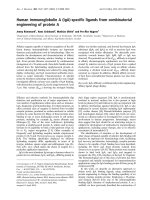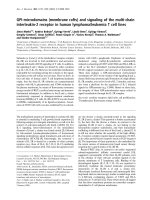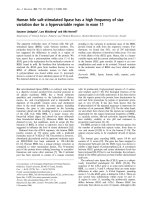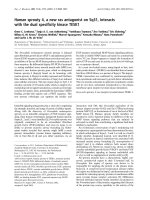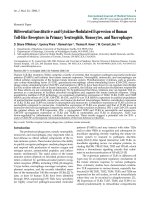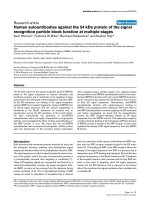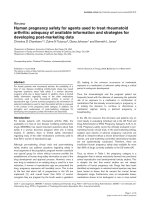Báo cáo y học: "Human prostate supports more efficient replication of HIV-1 R5 than X4 strains ex vivo" pdf
Bạn đang xem bản rút gọn của tài liệu. Xem và tải ngay bản đầy đủ của tài liệu tại đây (2.42 MB, 11 trang )
BioMed Central
Page 1 of 11
(page number not for citation purposes)
Retrovirology
Open Access
Research
Human prostate supports more efficient replication of HIV-1 R5
than X4 strains ex vivo
Anna Le Tortorec
1,2
, Anne-Pascale Satie
1,2
, Hélène Denis
1,2
, Nathalie Rioux-
Leclercq
4,5
, Laurence Havard
3
, Annick Ruffault
3
, Bernard Jégou
1,2
and
Nathalie Dejucq-Rainsford*
1,2
Address:
1
Inserm, U625, Rennes, France,
2
Univ Rennes I, Campus de Beaulieu, IFR-140, GERHM, Rennes, F-35042, France,
3
Unité de
rétrovirologie, CHU Pontchaillou, Rennes, France,
4
Service d'anatomie et cytologie pathologiques, CHU Pontchaillou, Rennes, France and
5
CNRS/
UMR6061, IFR140, Faculté de Médecine, Université de Rennes1, France
Email: Anna Le Tortorec - ; Anne-Pascale Satie - ;
Hélène Denis - ; Nathalie Rioux-Leclercq - ; Laurence Havard - annick.ruffault@univ-
rennes1.fr; Annick Ruffault - ; Bernard Jégou - ; Nathalie Dejucq-
Rainsford* -
* Corresponding author
Abstract
Background: In order to determine whether human prostate can be productively infected by
HIV-1 strains with different tropism, and thus represent a potential source of HIV in semen, an
organotypic culture of prostate from men undergoing prostatic adenomectomy for benign prostate
hypertrophy (BPH) was developed. The presence of potential HIV target cells in prostate tissues
was investigated using immunohistochemistry. The infection of prostate explants following
exposures with HIV-1 R5, R5X4 and X4 strains was analyzed through the measure of RT activity
in culture supernatants, the quantification of HIV DNA in the explants and the detection of HIV
RNA+ cells in situ.
Results: The overall prostate characteristics were retained for 2
1/2
weeks in culture. Numerous
potential HIV-1 target cells were detected in the prostate stroma. Whilst HIV-1 R5
SF162
strain
consistently productively infected prostatic T lymphocytes and macrophages, the prototypic X4
IIIB
strain and a primary R5X4 strain showed less efficient replication in this organ.
Conclusion: The BPH prostate is a site of HIV-1 R5 replication that could contribute virus to
semen. A limited spreading of HIV-1 X4 and R5X4 in this organ could participate to the preferential
sexual transmission of HIV-1 R5 strains.
Background
Although semen represents the foremost vector of HIV-1
dissemination worldwide, the origin of the infected leu-
kocytes and free viral particles contaminating the seminal
plasma is still unclear. Semen represents a viral compart-
ment distinct from the blood (reviewed in [1]), strongly
suggesting the existence of productive sources within the
male genital tract. The male reproductive tract could con-
Published: 31 December 2008
Retrovirology 2008, 5:119 doi:10.1186/1742-4690-5-119
Received: 20 November 2008
Accepted: 31 December 2008
This article is available from: />© 2008 Le Tortorec et al; licensee BioMed Central Ltd.
This is an Open Access article distributed under the terms of the Creative Commons Attribution License ( />),
which permits unrestricted use, distribution, and reproduction in any medium, provided the original work is properly cited.
Retrovirology 2008, 5:119 />Page 2 of 11
(page number not for citation purposes)
stitute a sanctuary for HIV-1 replication, since HIV-1 can
persist in the semen of seropositive men on highly active
antiretroviral therapy (HAART) in the absence of detecta-
ble levels of viral RNA in plasma [2-7]. Knowing the
sources contributing virus to semen is essential to promot-
ing the design of therapies aimed at eradicating virus from
semen.
Semen is composed of secretions and cells from the testes,
epididymides, prostate, seminal vesicles and urethral
glands. Earlier studies showed that vasectomy has little
impact on seminal shedding of HIV-1 [8-11], indicating
that testes and epididymides are not the main sources of
viral load in semen. The prostate could represent an
important source of virus in the semen, since prostate
secretions constitute 30% of the seminal fluid and the
human prostate is frequently inflammed, encompassing
leukocytic infiltrates that may represent target cells for
HIV infection (for a review, [12]). We recently demon-
strated that the prostate of asymptomatic macaques is
productively infected by SIV and displays higher level of
infection than the testes and the epididymides [13]. In
human, indirect evidence suggests that the prostate is
infected and constitutes an early viral reservoir. Thus, pro-
static massages performed on asymptomatic HIV-1+ men
with no detectable seminal viral load induce the release of
virus in the semen [14], and the expressed prostatic secre-
tions from HIV-1+ men with or without ART are consist-
ently positive for HIV RNA [15]. However, for obvious
clinical and ethical reasons, in-depth investigations of
HIV infection of the prostate of HIV+ asymptomatic men
have never been performed.
In vitro studies using a number of different human organs,
including the testis [16], have proved invaluable for
improving the understanding of HIV pathogenesis. To test
the hypothesis that the human prostate represents a
source of virus in semen, we used an organotypic culture
of prostate tissue obtained from men with benign prostate
hypertrophy (BPH), a common non-malignant pathol-
ogy, to assess whether the resident immune cells or other
cell types present in this organ are susceptible to infection
by HIV-1 strains with various co-receptor requirements.
Methods
Chemicals and reagents
The following reagents were used: DMEM, RPMI 1640
(Gibco BRL, Life Technologies, Cergy-Pontoise, France),
fetal calf serum (FCS), sodium pyruvate (Eurobio, Court-
aboeuf, France), glutamine (Gibco BRL), insulin, vitamin
A, vitamin C, vitamin E, dihydrotestosterone, phytohe-
magglutinin (Sigma, Sigma-Aldrich Corp., St. Quentin
Fallavier, France), penicillin-streptomycin (Eurobio) and
interleukin-2 (Boehringer-Mannheim, Germany).
Antibodies, plasmids and cell lines
The following mouse monoclonal antibodies against
human proteins and matching isotype controls were used:
anti-CD68 (clone KP1), -CD3 (clone F.7.2.38)(7 μg/ml),
– HLA-DR (clone TAL.1B5), -Ki-67 (clone MIB-1) (DAKO,
Trappes, France), -PSA (clones ER-PR8 and PA05 from
Neomarkers), and -CD4 (clone 1F6, Novocastra, Newcas-
tle, UK) with mouse IgG1 (DAKO), anti-CCR5 (clone
45523) and IgG2b (R&D Systems, Minneapolis, MN),
anti-CXCR4 (clone 12G5; Dr. J. Hoxie, NIBSC Centralized
Facility for AIDS Reagent, UK), – alpha-smooth muscle
actin (clone 1A4, DAKO), – p63 (clone 4A4, DAKO) and
IgG2a (R&D Systems).
The pNL4.3 plasmid was provided by F. Mamano (Inserm
U552, Paris, France). Human T-Lymphoblastoïd C8166
cell line was obtained from the NIBSC Centralized Facility
for AIDS Reagent.
Viral stocks
HIV-1 clade B R5
SF162
, X4
IIIB
strains and R5X4
92US723
pri-
mary isolate (ARP1039.3) were obtained from the NIBSC
Centralized Facility for AIDS Reagent and expanded in
activated human PBMCs (R5
SF162
, R5X4
92US723
, X4
IIIB
) or
in C8166 cells (X4
IIIB
) to provide viral stocks of 40 000 pg/
ml for R5
SF162
, 40 000 pg/ml (PBMCs) to 60 000 pg/ml
(C8166) for X4
IIIB
and 10 000 pg/ml for R5X4
92US723
as
determined by RT activity assay.
Organotypic culture of human prostate explants
The protocol was approved by the local ethics committee
of Rennes, and informed consent was obtained from the
donors. Prostates tissues were obtained at the Rennes Uni-
versity Hospital from healthy, HIV-1 seronegative patients
(age range 50–55) who underwent prostatic adenomec-
tomy for BPH. Immediately following surgery, prostate
tissues were placed at 4°C in fresh medium and processed
within one hour. The benign pathological status was con-
firmed by histological examination. Prostate tissue from
the transition zone and the central zone was dissected into
3-mm
3
fragments, and two explants were transferred onto
a polyethylene terephtalate (PET) insert in a well of a 12-
well tissue culture plate (Falcon Labware; Becton-Dickin-
son and Co., Lincoln Park, NJ) containing 1 ml of media
(DMEM supplemented with antibiotics, 10% FCS, 1
mmol/L sodium pyruvate, 1 mmol/L glutamine, 100 ng/
ml vitamin A, 200 ng/ml vitamin E, 50 ng/ml vitamin C,
0.5 μg/ml insulin, and 800 ng/ml 5α-dyhydrotestoster-
one). Each experimental condition was made up of two
wells of two biopsies per well. The culture was established
for 17 days in a humidified atmosphere containing 5%
CO2 at 37°C, medium was changed every 2 days, and
stored frozen at -80°C. Every 2 days, prostate explants
were either fixed in neutral buffered 4% formaldehyde or
frozen and stored at -80°C.
Retrovirology 2008, 5:119 />Page 3 of 11
(page number not for citation purposes)
Immunohistochemistry and cell count
Immunohistochemistry using avidin-biotin peroxidase
complex technique was performed on formaldehyde-
fixed, paraffin-embedded tissues as previously described
[16]. No staining was ever observed with isotype control
antibodies or control serum. Stained positive cells were
counted in the total surface of the tissue section in a min-
imum of three independent cultures using the Cast Grid
software (Olympus).
Infection of prostate explants
Immediately after dissection, two fragments of human
prostate tissue (~3 mm
3
each) were immersed in either
200 μl (for R5
SF162
and X4
IIIB
) or 600 μl (for R5X4
92US723
)
of cell-free viral supernatant for 3 hours at 37°C and then
thoroughly rinsed three times in PBS. The explants were
placed in culture as described above, and the culture
medium replaced and collected every 2 days throughout
the culture and stored at -80°C for RT and viral infectivity
assays.
Reverse Transcriptase (RT) activity assay
Frozen culture supernatants were assayed in duplicates for
RT activity using the Lenti-RT activity assay (Cavidi Tech,
Uppsala, Sweden) according to the manufacturer's
instructions. Unknown values were obtained from the
standard curve interpolation and were expressed as pg/ml
of RT.
Simultaneous in situ hybridization and
immunohistochemical staining
Identification of cell types expressing HIV-1 RNA was per-
formed by combining radioactive in situ hybridization for
HIV-1 gag and immunohistochemical staining for cell
markers, as previously described [16]. The specificity of
the hybridization signal was systematically checked by
hybridizing sense probes on parallel sections and anti-
sense probes on uninfected prostate tissue.
Viral infectivity assay
500 μl of prostate culture supernatants collected at day 17
after infection, or 500 μl of viral stock maintained at 37°C
for 17 days (used here as a negative control) were ultra-
centrifuged for 1 hour at 17 000 rpm. Supernatants were
discarded and pellets dissolved in 500 μl of RPMI 1640,
which was added to 4 × 10
6
phytohemagglutinin-acti-
vated PBMCs for 3 hours at 37°C. After a 10-minute cen-
trifugation at 1200 rpm, PBMCs were re-suspended in 2
ml of RPMI 1640 supplemented with 5% interleukin-2
and maintained at 37°C for 14 days. Culture medium was
changed every 3 days and stored frozen at -80°C for sub-
sequent RT assay.
Measurement of HIV-1 DNA using TaqMan real-time PCR
Total DNA was extracted using the QIAamp DNA Mini Kit
(Qiagen) according to the manufacturer's instructions.
Quantitative real time PCR was performed on 250 ng
DNA as previously described, using primers and probes
for HIV-1 LTR and albumin gene amplification [16,17].
For each donor and each time point, two separate pieces
of tissue were analyzed in duplicate. Results were
expressed as copy number of Log10 HIV DNA copy
number/million cells.
Statistics
All values are the mean ± SEM. The significance of the dif-
ferences between values was evaluated using Dunnett test.
This test controls the Type I experiment-wise error for
comparisons of all samples against a control (described in
the figure legends). A value of p < 0.05 was considered sta-
tistically significant.
Results
Characterization of human prostate in organotypic
culture
The morphology and expression of prostatic cell markers
were compared in prostate explants before culture and
throughout the culture period. Histological examination
of prostatic fragments revealed that the tissue architecture
was maintained during the 17 day culture period (Fig. 1A
versus F). Staining for α smooth actin before culturing
revealed the presence of numerous smooth muscle cells
and myofibroblasts as well as unstained stromal cells (i.e.
fibroblasts, leukocytes and endothelial cells). After 17
days of culture, whilst the same global profile of staining
was observed, a diminution of the number of stromal
cells, mainly in the centre of the explants was noticed (Fig.
1B versus G). Epithelial basal cells (p63+, PSA-) surround-
ing the acini were maintained throughout the culture (Fig.
1C, H) and were seen encapsulating the explants from day
4 of culture (data not shown). Luminal columnar epithe-
lial cells (PSA+, p63-) maintained their ability to produce
PSA for up to 4 days of culture (Fig. 1D versus I). After 8
days of culture, PSA expression in these cells became
undetectable, although PSA positive secretions were still
found in acini lumen by day 17 (Fig. 1J). In the explants
before and after culture, only a small cell number was pro-
liferating, as shown by the detection of Ki67 (Fig. 1E, K).
Detection and quantification of potential HIV-1 target
cells in human BPH prostate
Cells staining positive for the activated immune cells
marker HLA-DR (Fig. 2A), the T lymphocyte marker CD3
(Fig. 2C), the T helper lymphocyte marker CD4 (Fig. 2B),
and the myeloid cell marker CD68 (Fig. 2D) were found
within the stroma of fixed prostate tissues from all donors
before culture, either scattered or in periglandular foci
(mainly composed of HLA-DR+, CD3+ and CD4+cells;
serial sections, Fig. 2A, B). These immune cells were also
occasionally found as isolated cells inserted within the
epithelium of the glands (arrows, Fig. 2). The HIV co-
receptors CCR5 (Fig. 2E) and CXCR4 (Fig. 2F) were
Retrovirology 2008, 5:119 />Page 4 of 11
(page number not for citation purposes)
Characterization of human prostate in organotypic cultureFigure 1
Characterization of human prostate in organotypic culture. Paraformaldehyde-fixed paraffin sections were examined
morphologically and immunostained for several prostatic cell markers before culture (A-E) and after 4 days (I) or 17 days (F-H,
J, K) of culture. (A, F): a mix of normal and hyperplasic glands (identified by stars) were observed in the tissue sections before
and after 17 days of culture. The overall morphology of the organ was preserved after 17 days of culture despite a loss of stro-
mal cells in some areas (F). The markers used for the characterization of prostatic cell types were: – α smooth actin for
smooth muscle and myofibroblastic stromal cells (B, G); – p63 for basal epithelial cells (C, H); – PSA for secretory luminal epi-
thelial cells (D, I, J); – Ki67 for proliferating cells (E, K). The results are representative of a minimum of three independent cul-
tures performed on prostates collected from different donors. Scale bars = 50 μm.
G
B
C
H
D
I
J
A F
E K
*
*
*
**
Retrovirology 2008, 5:119 />Page 5 of 11
(page number not for citation purposes)
Presence of potential HIV target cells in the human prostateFigure 2
Presence of potential HIV target cells in the human prostate. Immunohistochemistry on uninfected prostate sections
before culture showed the presence of periglandular foci of HLA-DR+ (A) and CD4+ cells (B, serial section with A) as well as
scattered stromal cells staining positive for HLA-DR (A), CD4 (B), CD3 (C), CD68 (D), CCR5 (E) and CXCR4 (F). The arrows
point out immune cells inserted within the epithelium-Scale bars = 50 μm; (G): the respective proportions of CD3, CD4,
CD68, CXCR4 and CCR5+ cells per surface unit were evaluated on whole prostate sections from a minimum of 3 donors
whose explants were subsequently exposed to HIV-1 strains.
G
D
E
C
F
A
B
0
50
100
150
200
250
300
CD3 CD4 CD68 CXCR4 CCR5
Positive cells/mm
2
Retrovirology 2008, 5:119 />Page 6 of 11
(page number not for citation purposes)
detected on cells with immune cell type morphology.
Quantitative immunohistochemistry indicated that CD3+
T lymphocytes consistently out-numbered CD68+ mye-
loid cells whilst CXCR4+ cells were more frequently
encountered than CCR5+ cells in the prostatic tissue sec-
tions examined (Fig. 2G). Staining for all these cell popu-
lations was still observed at the end of the culturing
period (data not shown).
Infection of prostate explants with R5, R5X4 and X4 HIV-
1 strains
Following the incubation of R5
SF162
with prostate explants
from 3 donors, a significant increase in RT activity was
consistently observed at day 17 of culturing (Fig. 3A).
Viral particles obtained by centrifugation of prostate
supernatants collected at the end of the culturing time
productively infected activated PBMCs (Fig. 3B), whilst an
inoculum of the SF162 viral stock left in the culture
medium for 17 days at 37°C did not trigger PBMCs infec-
tion, indicating that infection was caused by newly
released virions and not by the potential remains of the
initial inoculum. Exposure of prostate tissues to
R5X4
92US723
primary isolate induced lower RT activity
increases than R5
SF162
, and the RT level was highly varia-
ble depending on the patient (Fig. 3C). Accordingly,
highly variable levels of productive infection of PBMCs by
R5X4-infected prostate culture supernatants were
observed (Fig. 3D). In contrast, in supernatants of
matched blocks of prostate tissues (same patients) and in
prostate tissues from two additional patients exposed to
X4
IIIB
grown in C8166, no or extremely low increases in RT
activity were detected during the 17 day-culture period
(Fig. 3E). The supernatants from X4
IIIB
-exposed prostate
cultures triggered either no or very low infection of
PBMCs (Fig. 3F). Similar results were obtained using X4
IIIB
stocks grown in PBMCs (data not shown).
The quantity of HIV DNA within the prostate explants
exposed to either R5
SF162
or X4
IIIB
was measured using Q-
PCR (Fig. 4). HIV-1 DNA level rose from 7 days onwards
post-exposure to R5
SF162
(on average, + ≈ 0.7 Log at day
13 and + ≈ 2.4 Log at day 17), demonstrating productive
infection. In contrast, no increase of HIV DNA was
observed in prostate explants exposed to X4
IIIB
between
day 7 and 13. Although relatively modest (on average ≈
0.6 Log), an increase was observed at the end of the cul-
turing period (Fig. 4), indicating a low level of X4
IIIB
repli-
cation. Of note, the overall morphology and the cellular
expression of PSA, p63, α smooth actin and Ki67 of the
infected explants at day 4, 11 and 17 of culture was similar
to those of uninfected explants (data not shown).
Localization and characterization of HIV-1 RNA+ cells in
BPH prostate explants
Infected cells were localized within the explants by in situ
hybridization for HIV-1 gag mRNA and characterized by
combined immunohistochemistry for cell markers (Fig.
5). In all explants exposed to R5
SF162
, and in those
exposed to R5X4
92US723
, mostly isolated and occasional
groups of HIV-1 RNA positive cells were detected in the
prostatic stroma (Fig. 5A, B). A few HIV+ cells were also
observed close to, or inserted within, the prostatic epithe-
lium (Fig. 5C). HIV+ cells co-localized with CD3 (Fig. 5B,
B', C, C') and, more rarely, with CD68 (Fig. 5A, A').
Scarcely distributed CD3+HIV-1+ cells were detected in
the stroma of X4
IIIB
-exposed prostate explants with low RT
activity (data not shown).
Discussion
Whilst few previous studies have detected HIV-1 within
the morphologically abnormal prostate from AIDS
deceased men [11,18-20], the susceptibility to HIV-1
infection of the prostate from asymptomatic men has not
been thoroughly explored. Here, we used an organotypic
culture of prostate tissue from HIV-negative men with
benign prostatic hypertophy (BPH) to investigate infec-
tion by R5, R5X4 and X4 HIV-1 strains and to determine
the nature of the target cells within this organ.
BPH is an extremely common disease (for a review,
[21]). Starting from 35 years of age, its frequency
increases with age, and it affects 50 to 75% of men
over 50 years old. It leads to an enlarged prostate
which although benign and non-malignant may
necessitate surgery to eliminate discomfort. Most BPH
lesions develop in the transition and central zones of
the prostate and are composed of epithelial, muscular
and/or stromal hyperplasia. Inflammatory infiltrates
are often present in and around the glandular or fibro-
muscular BPH nodules [12]. In our BPH tissues, T lym-
phocytes (mean of 220 cells/mm
2
), mainly stromal
CD4+, were more numerous than CD68+ myeloid
cells and were found either scattered or in foci. These
results are in agreement with previous qualitative and
quantitative studies on immune cell populations
within BPH prostates, showing the predominance of T
lymphocytes (mean of 195 cells/mm
2
, mainly stromal
memory CD4+T cells and a few intraepithelial CD8+
cells) over macrophages and B cells [22-24]. Normal
prostate (i.e. from asymptomatic prostate disease-free
men) contains scattered stromal and intraepithelial T
and B lymphocytes, macrophages and mast cells [23],
but also frequently displays focal accumulation of
CD4+T lymphocytes in the stroma [25-27]. As a matter
of fact, most adult prostate tissues, with or without
prostatic pathology, contain various extent of inflam-
matory infiltrates, most commonly composed of a
majority of stromal T cells (reviewed in [12,28]. The
source of intraprostatic inflammation is often
unknown but might be caused by dietary factors, hor-
monal exposure variations, infection, or cell injury
(for a review [12]).
Retrovirology 2008, 5:119 />Page 7 of 11
(page number not for citation purposes)
HIV-1 R5, R5X4 and X4 infection of human prostate in organotypic cultureFigure 3
HIV-1 R5, R5X4 and X4 infection of human prostate in organotypic culture. RT activity was measured in superna-
tants of human prostate explants exposed to HIV-1 R5
SF162
(n = 3 donors) (A), R5X4
92US723
(n = 3 donors) (C), or X4
IIIB
(n = 5
donors) (E); and in supernatants of activated PBMCs exposed to day 17 supernatants of prostate explant cultures exposed to
R5
SF162
(n = 3) (B), R5X4
92US723
(n = 3) (D) or X4
IIIB
(n = 5) (F). RT activity was never detected in the supernatants of PBMCs
infected with an inoculum of the respective viral stocks maintained at 37°C in medium for 17 days. Each dot represents the
mean ± SEM of three to five independent cultures (Dunnett test; *, P < 0.05; control: day 7).
A
Days post-infection
RT (pg/ml)
B
Days post-infection
RT (pg/ml)
CD
RT (pg/ml)
Days post-infection
RT (pg/ml)
EF
RT (pg/ml)
Days post-infection
Days post-infection
RT (pg/ml)
Prostate explants
PBMCs
17
80
60
40
20
0
R5
SF162
17
80
60
40
20
0
X4
IIIB
20000
15000
10000
5000
0
371014
20000
15000
10000
5000
0
Days post-infection
20000
15000
10000
5000
3 7 10 14
3 7 10 14
0
80
60
40
20
0
7 9 11 13 15
177 9 11 13 15
11 1579 13
R5X4
92US723
*
*
*
*
Retrovirology 2008, 5:119 />Page 8 of 11
(page number not for citation purposes)
The culture conditions selected for the organotypic culture
of human prostate that we developed from BPH tissues
were based both on our own experience of organ culture
[29] and on previous descriptions of prostate organ cul-
ture selected from the literature [30-32]. The culturing
method of using well inserts was chosen for its ease of
manipulation in the context of a high security laboratory,
as opposed to other methods which required specific
material [33]. The culture allowed for the preservation of
the overall tissue architecture and the maintenance of all
the prostatic cell types for 2.5 weeks ex vivo. Both normal
and hyperplasic glands were observed before and after
culturing. No increased proliferation of any specific cell
type was observed after culturing. The constraint of work-
ing on explants of very small size in order to preserve tis-
sue integrity did not allow for accurate quantification of
immune cells throughout the culture. However, we une-
quivocally found that all the immune cell types identified
before culturing were still present by day 17.
We demonstrated here for the first time that human pros-
tate from men with BPH is selectively infected by HIV-1
and releases infectious virions. Infected cells were mainly
localized within the stroma and were rarely found within
the epithelium, whether hyperplasic or normal. Their phe-
notype corresponded to either lymphocytes or macro-
phages, which, as previously evidenced by us and others,
can be inserted within the epithelium [13,23,25-27]. Epi-
thelial cells in the BPH prostate explants never stained
positive for HIV receptors CD4, CXCR4 or CCR5 in
immunohistochemistry. This confirms an in vitro study
showing an absence of CD4, CXCR4 or CCR5 surface
expression and the lack of productive infection by either
R5 or X4 virus strains of epithelial cells isolated from nor-
mal prostates [34]. Thus, unlike the renal epithelium that
supports HIV replication in vivo [35], the prostatic epithe-
lium does not constitute a site of active HIV infection.
The most efficiently and consistently replicating HIV-1
strain in prostate tissues was the prototypic R5
SF162
. Pros-
tate cultures were also susceptible to infection by a dual
tropic primary isolate; albeit replication of the R5X4 virus
was much lower than the R5 strain (which could reflect
the lower titre of R5X4 viral stock) and was variable
depending on the patients. As assessed by RT activity
measurement, infected cells were readily detected in situ
and the viral particles recovered from infected prostate
supernatants were able to subsequently infect PBMCs. In
contrast, despite a higher titre of viral stock, X4
IIIB
spread
in the prostate tissue was somewhat inefficient. This was
demonstrated by the absence (or the very low level) of RT
activity in infected culture supernatants after 17 days of
culture, the scarce detection of infected cells in the tissues,
and the fact that supernatants of prostate explants
exposed to X4 were rarely able to induce infection of
PBMCs. In addition, whilst in the prostate explants
infected with R5
SF162
HIV-1 DNA rose significantly from
day 7 onwards, a delayed and much lower increase was
observed within the explants exposed to X4
IIIB
. A longer
duration of prostate culture may have allowed for a rise in
X4 production, as suggested by the increase in X4 DNA
towards the end of the culture period; however, since the
prostate explant morphologies started to be disrupted
after 17 days, the culture was not carried out any further.
A similarly favoured replication of R5 over X4 strains has
been described in foreskin, cervical, skin epidermal and
fetal thymus explants [36-39]. In contrast, whilst rectosig-
moid explants supported efficient replication by both R5
and X4 strains, tonsil explants, which displayed low num-
bers of CCR5+ cells, were less efficiently infected by R5
strains [40]. In foreskin, a predominance of CCR5 over
CXCR4 expression by the tissue immune cells was
observed, and this could explain the X4 restriction [36]. In
our system, CXCR4 was readily detected and, in fact,
CXCR4+ cells outnumbered CCR5+ cells. Although differ-
ences in antibody sensitivities may have led to an under-
estimation of CCR5+ cells, the restriction in X4 replication
cannot be inferred as emerging from a lack of co-receptor
expression. However, we cannot rule out that CXCR4+
cells in the prostate are mainly inactivated/naive CD4+T
cells and/or CD8+T lymphocytes, both refractory to pro-
ductive infection. Another hypothesis is that the cytokine
environment of the prostate tissue restricts CXCR4-viral
entry and/or spread. Thus, a high expression of the CXCR4
ligand CXCL12 (SDF-1) could impair X4 infection of
prostate tissue, as previously described for the female gen-
ital mucosa [41,42]. However, the fact that viral DNA
accumulation in prostate explants was similar for R5
SF162
Accumulation of HIV-1 DNA in prostate explants following exposure to either R5
SF162
or X4
IIIB
, as assayed for LTR DNA by quantitative real time PCRFigure 4
Accumulation of HIV-1 DNA in prostate explants fol-
lowing exposure to either R5
SF162
or X4
IIIB
, as assayed
for LTR DNA by quantitative real time PCR. Each dot
represents the mean value of 2 paired explants (each tested
in duplicate PCR) from one individual. For each virus strain,
prostate explants from 2 patients were analyzed.
0
1
2
3
4
5
6
71317
R5
SF162
P1
R5
SF162
P2
X4
IIIB
P1
Days post-infection
Log HIV DNA copies/10
6
cells
X4
IIIB
P2
Retrovirology 2008, 5:119 />Page 9 of 11
(page number not for citation purposes)
and X4
IIIB
up to 7 days post-infection indicated that both
strains entered target cells and retrotranscribed their RNA
genome following virus exposure of prostate explants.
Afterwards, only R5 efficiently propagated in the explants,
whilst a much more modest rise in DNA was observed for
X4
IIIB
after 17 days. This suggests that the limited X4
spread in prostate tissue is not due to an entry inhibition
but rather resulted from either a slower replication kinetic
or a more restricted number of cells that supported effi-
cient replication following entry. In cervical explants, a
post-entry block due to the non-activated status of T lym-
phocytes was described for lab-adapted X4 and primary
isolates of X4, R5X4, or R5. This block was compensated
for in the prototypic R5
BaL
strain by its efficient spreading
in macrophages, while infecting only a few T lymphocytes
[37,43]. Although the prototypic R5
SF162
strain used in our
study can also efficiently spread in macrophages [44], the
fact that the main infected cell type for both R5 and R5X4
was T lymphocytes, indicated that the difference between
R5/R5X4 and X4 strains was not due to exclusive replica-
tion of the formers in macrophages, a cell type that X4
strains cannot productively infect [45]. One hypothesis is
that the limited replication of X4
IIIB
is due to a sub-opti-
mal level of activation of its target cells. Thus, sub-opti-
mally stimulated CD4+T cells have been shown to only
support the early steps of X4 viral replication. Whilst X4
replication in lymphocytes is a function of the time inter-
val from mitogenic stimulation, R5 viruses require less
stringent conditions of T-cell activation and are able to
replicate in all subsets of sub-optimally activated T lym-
phocytes [46]. Since inflammatory infiltrates of BPH pros-
tate tissues are mainly constituted of chronically activated
CD4+ T cells, the activation status of those cells (i.e chron-
ically rather than acutely activated) may allow efficient
R5, but no X4, replication.
Conclusion
Our results demonstrated that the prostate is a site of R5
virus replication through the infection of the immune
cells present in the tissue. The less efficient spread of HIV-
Localization and characterization of HIV-1 RNA positive cells in the human prostate infected ex vivoFigure 5
Localization and characterization of HIV-1 RNA positive cells in the human prostate infected ex vivo. Localiza-
tion of HIV RNA+ cells (black silver grains) in prostate explants exposed for 17 days to R5
SF162
(A, C) or R5X4
92US723
(B) using
in situ hybridization for HIV-1 gag. Combined ISH with immunostaining for cell markers was used to assess co-localization of
HIV RNA+ cells with either CD68 (A) or CD3 (B, C). A'-C' correspond to higher magnification of A-C showing cells co-
labelled for HIV RNA (black silver grains) and cell marker (brown cells). Scale bars = 20 μm.
B’
A
B
C
A’
C’
Retrovirology 2008, 5:119 />Page 10 of 11
(page number not for citation purposes)
1 X4 virus observed in the prostate explants could contrib-
ute to the preferential sexual transmission of HIV-1 R5
strains. Whether restricted X4 replication occurs in the
prostate of HIV patients awaits further investigations,
since different conditions such as the level of immune cell
activation and the cytokine environment may modify X4
virus replication in the prostate in vivo.
Competing interests
The authors declare that they have no competing interests.
Authors' contributions
ALT, APS, HD, NRL, LH performed the experiments; NRL,
AR, BJ contributed reagents/materials/analysis tools; ALT,
APS, HD, NLR, AR, ND analyzed the data; ND conceived
and designed the experiments.
Acknowledgements
We thank Christine Monfort for statistical analysis.
Sources of support – ANRS, Région Bretagne, Inserm – ALT was supported
by Organon and ANRS stipends, H.D. were supported by ANRS and
Région Bretagne.
References
1. Dejucq-Rainsford N, Jégou B: Viruses in semen and male genital
tissues: consequences for the reproductive system and ther-
apeutic perspectives. Current Pharmaceutical Design 2004,
10:557-575.
2. Zhang H, Dornadula G, Beumont M, Livornese LJ, Van Uitert B, Hen-
ning K, Pomerantz RJ: Human immunodeficiency virus type 1 in
the semen of men receiving highly active antiretroviral ther-
apy. N Engl J Med 1998, 339:1803-1809.
3. Kiessling AA, Fitzgerald LM, Zhang D, Chhay H, Brettler D, Eyre RC,
Steinberg J, McGowan K, Byrn RA: Human immunodeficiency
virus in semen arises from a genetically distinct virus reser-
voir. AIDS Res Hum Retroviruses 1998, 14:S33-S41.
4. Mayer KH, Boswell S, Goldstein R, Lo W, Xu C, Tucker L, DePas-
quale MP, D'Aquila R, Anderson DJ: Persistence of human immu-
nodeficiency virus in semen after adding indinavir to
combination antiretroviral therapy. Clin Infect Dis 1999,
28:1252-1259.
5. Lafeuillade A, Solas C, Halfon P, Chadapaud S, Hittinger G, Lacarelle
B: Differences in the detection of three HIV-1 protease inhib-
itors in non-blood compartments: Clinical correlations. HIV
Clin Trials 2002, 3:27-35.
6. Solas C, Lafeuillade A, Halfon P, Chadapaud S, Hittinger G, Lacarelle
B: Discrepancies between Protease Inhibitor Concentrations
and Viral Load in Reservoirs and Sanctuary Sites in Human
Immunodeficiency Virus-Infected Patients. Antimicrob Agents
Chemother 2003, 47:238-243.
7. Bujan L, Daudin M, Matsuda T, Righi L, Thauvin L, Berges L, Izopet J,
Berrebi A, Massip P, Pasquier C: Factors of intermittent HIV-1
excretion in semen and efficiency of sperm processing in
obtaining spermatozoa without HIV-1 genomes. Aids 2004,
18:757-766.
8. Anderson DJ, Politch JA, Martinez A, Van Voorhis BJ, Padian NS,
O'Brien TR: White blood cells and HIV-1 in semen from vasec-
tomised seropositive men. Lancet 1991, 338:573-574.
9. Schwartz GG: Vasectomy and human immunodeficiency virus
of mice and men. Fertil Steril 1991, 55:650-651.
10. Krieger JN, Nirapathpongporn A, Chaiyaporn M, Peterson G,
Nikolaeva I, Akridge R, Ross SO, Coombs RW: Vasectomy and
human immunodeficiency virus type 1 in semen. J Urol 1998,
159:820-825.
11. Paranjpe S, Craigo J, Patterson B, Ding M, Barroso P, Harrison L,
Montelaro R, Gupta P: Subcompartmentalization of HIV-1
Quasispecies between Seminal Cells and Seminal Plasma
Indicates Their Origin in Distinct Genital Tissues. AIDS Res
Hum Retroviruses 2002, 18:1271-1280.
12. De Marzo AM, Platz EA, Sutcliffe S, Xu J, Gronberg H, Drake CG,
Nakai Y, Isaacs WB, Nelson WG: Inflammation in prostate car-
cinogenesis. Nat Rev Cancer 2007, 7:256-269.
13. Le Tortorec A, Le Grand R, Denis H, Satie AP, Mannioui K, Roques
P, Maillard A, Daniels S, Jegou B, Dejucq-Rainsford N: Infection of
semen-producing organs by SIV during the acute and
chronic stages of the disease. PLoS ONE 2008, 3:e1792.
14. Smith DM, Kingery JD, Wong JK, Ignacio CC, Richman DD, Little SJ:
The prostate as a reservoir for HIV-1. Aids 2004, 18:1600-1602.
15. Coombs RW, Lockhart D, Ross SO, Deutsch L, Dragavon J, Diem K,
Hooton TM, Collier AC, Corey L, Krieger JN: Lower genitouri-
nary tract sources of seminal HIV. J Acquir Immune Defic Syndr
2006, 41:430-438.
16. Roulet V, Satie AP, Ruffault A, Le Tortorec A, Denis H, Guist'hau O,
Patard JJ, Rioux-Leclerq N, Gicquel J, Jegou B, Dejucq-Rainsford N:
Susceptibility of human testis to human immunodeficiency
virus-1 infection in situ and in vitro. Am J Pathol 2006,
169:2094-2103.
17. Desire N, Dehee A, Schneider V, Jacomet C, Goujon C, Girard PM,
Rozenbaum W, Nicolas JC: Quantification of human immuno-
deficiency virus type 1 proviral load by a TaqMan real-time
PCR assay. J Clin Microbiol 2001, 39:1303-1310.
18. Da Silva M, Shevchuk MM, Cronin WJ, Armenakas NA, Tannenbaum
M, Fracchia JA, Ioachim HL: Detection of HIV related protein in
testes and prostates of patients with AIDS. Am J Clin Pathol
1990, 93:196-201.
19. Ablin RJ: HIV-related protein in the prostate: a possible reser-
voir of virus. Am J Clin Pathol 1991, 95:759-760.
20. Pudney J, Anderson D: Orchitis and human immunodeficiency
virus type 1 infected cells in reproductive tissues from men
with the acquired immune deficiency syndrome. Am J Pathol
1991, 139:149-160.
21. Kramer G, Mitteregger D, Marberger M: Is benign prostatic
hyperplasia (BPH) an immune inflammatory disease? Eur
Urol 2007, 51:1202-1216.
22. McClinton S, Miller ID, Eremin O: An immunohistochemical
characterisation of the inflammatory cell infiltrate in benign
and malignant prostatic disease. Br J Cancer 1990, 61:400-403.
23. Theyer G, Kramer G, Assmann I, Sherwood E, Preinfalk W, Mar-
berger M, Zechner O, Steiner GE: Phenotypic characterization
of infiltrating leukocytes in benign prostatic hyperplasia. Lab
Invest 1992, 66:96-107.
24. Steiner G, Gessl A, Kramer G, Schollhammer A, Forster O, Mar-
berger M: Phenotype and function of peripheral and prostatic
lymphocytes in patients with benign prostatic hyperplasia. J
Urol 1994, 151:480-484.
25. El-Dermiry M, Hargreave T, Busuttil A, James K, Ritchie A, Chrisholm
G: Lymphocyte subpopulations in the male genital tract. Br J
Urol 1985, 57:769.
26. Bostwick DG, de la Roza G, Dundore P, Corica FA, Iczkowski KA:
Intraepithelial and stromal lymphocytes in the normal
human prostate. Prostate 2003, 55:187-193.
27. Anderson DJ, Pudney J: Human male genital tract immunity
and experimental models. In Mucosal Immunology Volume 2. 3rd
edition. Edited by: Mestecky J, Lamm M, Strober W, Bienenstock J,
McGhee J, Mayer L. New-York, NY: Elsevier Academic Press;
2005:1647-1659.
28. Nickel JC, True LD, Krieger JN, Berger RE, Boag AH, Young ID: Con-
sensus development of a histopathological classification sys-
tem for chronic prostatic inflammation. BJU Int 2001,
87:797-805.
29. Roulet V, Denis H, Staub C, Le Tortorec A, Delaleu B, Satie AP,
Patard JJ, Jegou B, Dejucq-Rainsford N: Human testis in organo-
typic culture: application for basic or clinical research. Hum
Reprod 2006, 21:1564-1575.
30. Papini S, Rosellini A, Campani D, DeMatteis A, Selli C, Revoltella RP:
Selective growth of epithelial basal cells from human pros-
tate in a three-dimensional organ culture. Prostate 2004,
59:383-392.
31. Varani J, Dame MK, Wojno K, Schuger L, Johnson KJ: Characteris-
tics of nonmalignant and malignant human prostate in organ
culture. Lab Invest 1999, 79:723-731.
32. Parrish AR, Sallam K, Nyman DW, Orozco J, Cress AE, Dalkin BL,
Nagle RB, Gandolfi AJ: Culturing precision-cut human prostate
Publish with BioMed Central and every
scientist can read your work free of charge
"BioMed Central will be the most significant development for
disseminating the results of biomedical research in our lifetime."
Sir Paul Nurse, Cancer Research UK
Your research papers will be:
available free of charge to the entire biomedical community
peer reviewed and published immediately upon acceptance
cited in PubMed and archived on PubMed Central
yours — you keep the copyright
Submit your manuscript here:
/>BioMedcentral
Retrovirology 2008, 5:119 />Page 11 of 11
(page number not for citation purposes)
slices as an in vitro model of prostate pathobiology. Cell Biol
Toxicol 2002, 18:205-219.
33. Margolis L, Hatfill S, Chuaqui R, Vocke C, Emmert-Buck M, Linehan
WM, Duray PH: Long term organ culture of human prostate
tissue in a NASA-designed rotating wall bioreactor. J Urol
1999, 161:290-297.
34. Dezzutti CS, Guenthner PC, Cummins JE Jr, Cabrera T, Marshall JH,
Dillberger A, Lal RB: Cervical and prostate primary epithelial
cells are not productively infected but sequester human
immunodeficiency virus type 1. J Infect Dis 2001, 183:1204-1213.
35. Bruggeman LA, Ross MD, Tanji N, Cara A, Dikman S, Gordon RE,
Burns GC, D'Agati VD, Winston JA, Klotman ME, Klotman PE: Renal
epithelium is a previously unrecognized site of HIV-1 infec-
tion. J Am Soc Nephrol 2000, 11:2079-2087.
36. Patterson BK, Landay A, Siegel JN, Flener Z, Pessis D, Chaviano A,
Bailey RC: Susceptibility to human immunodeficiency virus-1
infection of human foreskin and cervical tissue grown in
explant culture. Am J Pathol 2002, 161:867-873.
37. Greenhead P, Hayes P, Watts PS, Laing KG, Griffin GE, Shattock RJ:
Parameters of human immunodeficiency virus infection of
human cervical tissue and inhibition by vaginal virucides. J
Virol 2000, 74:5577-5586.
38. Reece JC, Handley AJ, Anstee EJ, Morrison WA, Crowe SM, Cameron
PU: HIV-1 selection by epidermal dendritic cells during trans-
mission across human skin. J Exp Med 1998, 187:1623-1631.
39. Rosenzweig M, Bunting EM, Damico RL, Clark DP, Gaulton GN:
Human neonatal thymic organ culture: an ex vivo model of
thymocyte ontogeny and HIV-1 infection. Pathobiology 1994,
62:245-251.
40. Grivel JC, Elliott J, Lisco A, Biancotto A, Condack C, Shattock RJ,
McGowan I, Margolis L, Anton P: HIV-1 pathogenesis differs in
rectosigmoid and tonsillar tissues infected ex vivo with
CCR5- and CXCR4-tropic HIV-1. Aids 2007, 21:1263-1272.
41. Zaitseva M, Blauvelt A, Lee S, Lapham CK, Klaus-Kovtun V,
Mostowski H, Manischewitz J, Golding H: Expression and function
of CCR5 and CXCR4 on human Langerhans cells and macro-
phages: implications for HIV primary infection.
Nat Med 1997,
3:1369-1375.
42. Agace WW, Amara A, Roberts AI, Pablos JL, Thelen S, Uguccioni M,
Li XY, Marsal J, Arenzana-Seisdedos F, Delaunay T, et al.: Constitu-
tive expression of stromal derived factor-1 by mucosal epi-
thelia and its role in HIV transmission and propagation. Curr
Biol 2000, 10:325-328.
43. Hladik F, Lentz G, Akridge RE, Peterson G, Kelley H, McElroy A,
McElrath MJ: Dendritic cell-T-cell interactions support core-
ceptor-independent human immunodeficiency virus type 1
transmission in the human genital tract. J Virol 1999,
73:5833-5842.
44. Stamatatos L, Wiskerchen M, Cheng-Mayer C: Effect of major
deletions in the V1 and V2 loops of a macrophage-tropic HIV
type 1 isolate on viral envelope structure, cell entry, and rep-
lication. AIDS Res Hum Retroviruses 1998, 14:1129-1139.
45. Schmidtmayerova H, Alfano M, Nuovo G, Bukrinsky M: Human
immunodeficiency virus type 1 T-lymphotropic strains enter
macrophages via a CD4- and CXCR4-mediated pathway:
replication is restricted at a postentry level. J Virol 1998,
72:4633-4642.
46. Vicenzi E, Bordignon PP, Biswas P, Brambilla A, Bovolenta C, Cota M,
Sinigaglia F, Poli G: Envelope-dependent restriction of human
immunodeficiency virus type 1 spreading in CD4(+) T lym-
phocytes: R5 but not X4 viruses replicate in the absence of
T-cell receptor restimulation. J Virol 1999, 73:7515-7523.

